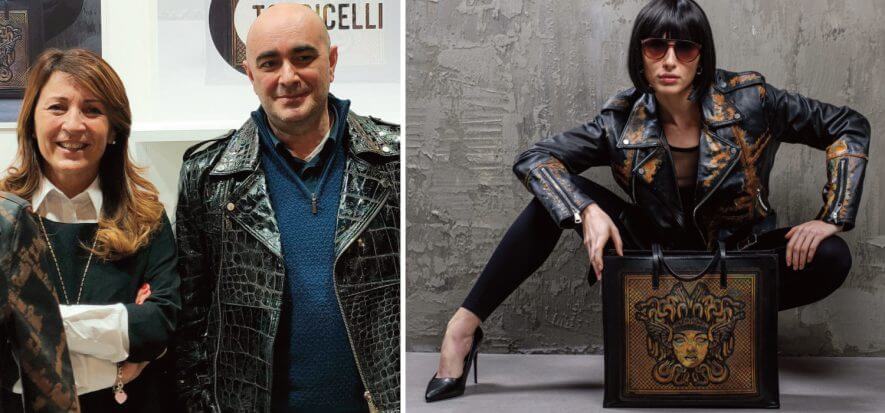Leather and real rust. Metaverse and sustainability. These are the four pillars of the Ruggine project presented at Mipel by debutant brand Cristiano Torricelli. Leather bags and bikers decorated with CTRust processing. In other words: real oxidised rust, anchored to the leather and then protected by a special film. A technique protected by patent. The leather used comes from the stock of a partner company. Production takes place on the sold. In addition to the physical garment, the customer also buys the virtual version to wear in the metaverse.
Cristiano Torricelli’s idea
Cristiano Torricelli (in the photo), originally from Novara, but now living in San Benedetto del Tronto (Ascoli Piceno), was an illustrator at the Walt Disney Academy in Milan. He then collaborated with Dainese and Sony PlayStation. He is a designer and craftsman. The eponymous brand is produced under licence by the start-up Do Quality, which involves the illustrator himself and Doriana Marini (on the left, in the photo), who runs Dienpi, a company specialising in “special contract work on fine leathers, bags and shoes for luxury goods”.
Leather and real rust
The Ruggine project focuses on sustainability and, in particular, on up-cycling. In fact, the hides used to make bags and bikers (calfskin and lamb respectively) come from Dienpi’s stock. “The oxidation process takes 12 hours,” explains Cristiano Torricelli. “The leather is then worked manually, with an airbrush and brush, on both the cut and the finished garment”. Doriana Marini emphasises that “processing only starts after we receive the purchase order from the customer. Delivery takes place within 4 weeks”.
Personalisation
The garments are personalised. Customisation can also be done remotely with the help of an online configurator. “Leather, being a natural product, does not react uniformly to contact with rust. If we compare two jackets with the same print, they look different from each other,” Torricelli remarks, emphasising the uniqueness of each product.
Metaverse
Finally, the metaverse comes into play. Each creation is associated with a unique, blockchain-authenticated NFT (Non-Fungible Token), which is given to the buyer. “The NFC label on the finished product, which can be activated by smartphone, also makes it possible to read the garment’s technical specifications. In other words, in addition to the physical good, you also buy the digital version, that can be worn in the metaverse,” concludes Torricelli.
Read also:











